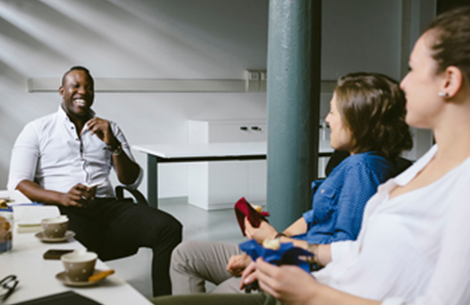“Work isn’t supposed to be fun. It’s called ‘work’ for a reason!”
Sound familiar? I’ve certainly heard comments like this from curmudgeonly colleagues over the years.
I frequently hear people criticize millennials for wanting work to be “fun.” And the media likes to bombard us with millennial-bashing images of immature young people who expect a party every day, scheming for nap pods, ping pong tables and beer on tap.
So you might be surprised to find out what else I frequently hear: older managers lamenting that work used to be so much more fun than it is now.
I’ve recently had conversations with baby boomers and Gen Xers at financial services and consumer packaged goods companies who have told me about how their work used to be more collegial, with more apprenticeship and team bonding, before outsourcing, downsizing, stricter travel and entertaining budgets and increased telecommuting took hold.
They mention how there used to be more informal networking opportunities, more manager discretion on entertaining and team events, and more chances to invite junior staff to client meetings because there wasn’t as much pressure on constant output and productivity.
Perhaps when we talk about millennials being pushy about wanting work to be fun, it’s more a case of “everything old is new again.” Here’s what I mean:
The ping pong table is the new “three martini lunch.”
In the past, teams would go out to lunch to and have a chance to get away from the office, blow off some steam and talk about something other than work. Of course, in retrospect, there were lots of problems with the three-martini lunch (see: any episode of Mad Men) so when you think about it, letting loose with colleagues at the ping pong table is a lot healthier. Bottom line: it’s a net positive to want to enjoy non-work time with colleagues.
Free snacks are the new “expense account dinner.”
In the past, we would often have leisurely meals with colleagues and clients, to discuss business but also to build deeper relationships. Today, business is more apt to take place over a conference call or email, and when you’re working late on a client project, you’re probably going to have to settle for raiding the kitchen or ordering in Seamless rather than heading to a favorite restaurant. I’m not saying every meal charged to a corporate card in the past was worthwhile, but perhaps one of the reasons there is less employee loyalty today is because we don’t know each other as well.
Volunteering is the new “ropes course.”
In the past, team bonding activities included “trust falls,” ropes courses and other contrived ice-breaking exercises. Now, teams are finding that they can get the same benefits of working together and getting to know one another outside of the office by volunteering and doing something positive for the community. In my opinion, increased opportunities for team volunteering and philanthropy is one of the best changes in the modern workplace. It’s both fun and meaningful.
Casual dress is the new power suit.
It used to be that most professionals would wear suits or uniforms because that’s what their peers and clients wore: It made everyone feel comfortable because they were all dressed alike. Cue “hoodie” culture and all of a sudden everyone (even at companies in conservative industries like finance, law and consulting) is dressing down so they look like their clients. While I’m still a fan of dressing to impress (especially in a client service business), I don’t think many people miss wearing pantyhose or three-piece suits in the ninety-five degree heat we had this past summer.
While “fun” is a concept that is often disparaged, I think millennials are really just asking for the human element to be injected back into the workplace. So instead of mocking millennials, maybe we should thank them for bringing back the fun in new, often healthier, ways.
Not Authorized
You are currently not authorized to access this section.
Please contact your Administrator to change your authorization settings.
Please contact your Administrator to change your authorization settings.


